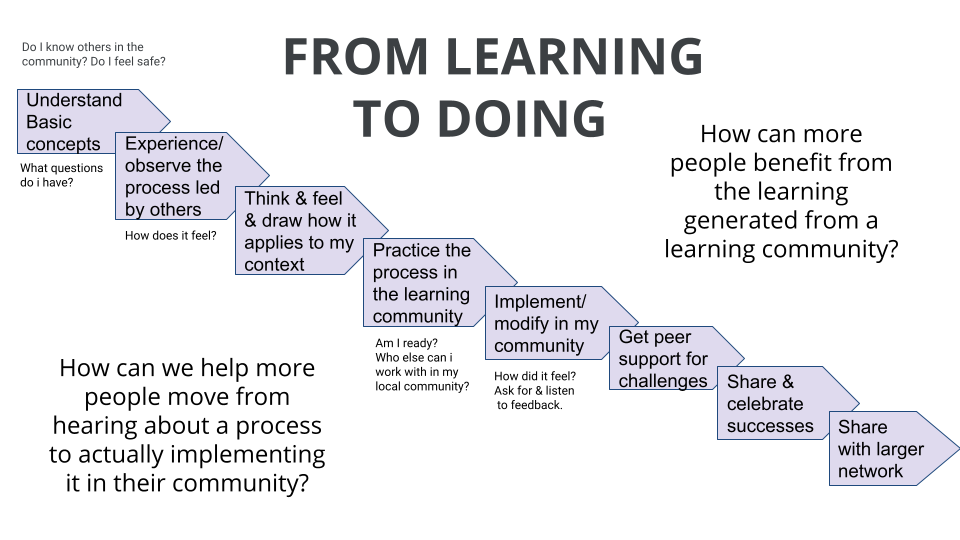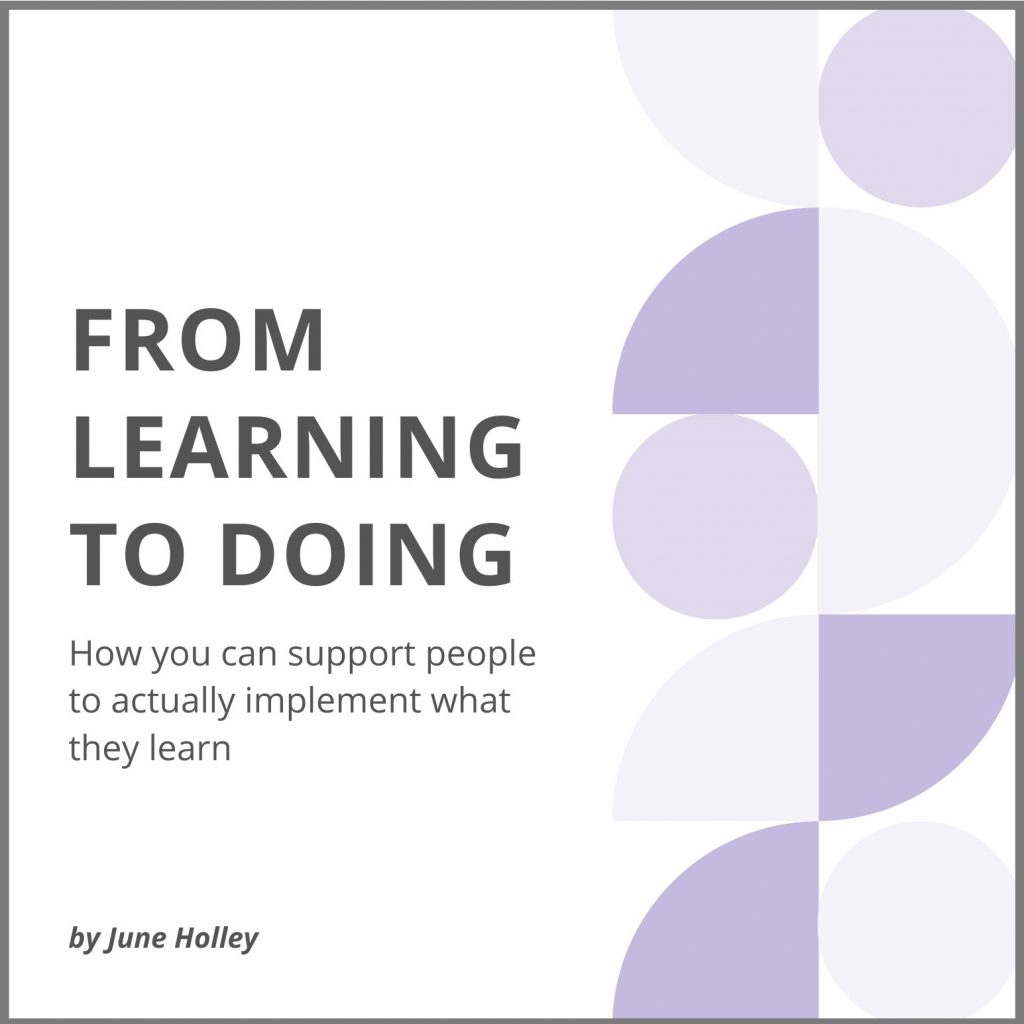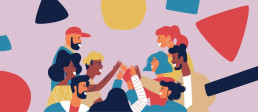Weaving at Work
Over the past few years, I have been increasingly influenced by the concept of “weaving” — what for me means connecting people, ideas, and projects to foster more collaborative social change.
Weaving is a skill, a mindset, and a way of being. More art than science, it requires deep listening, being responsive to interests and needs, and “sensing” opportunities to bring people or projects together.
In many ways, it’s synonymous with other terms we use like facilitation, collaboration, networking, community building, relational leadership, etc.
I find weaving to be an incredibly powerful tool for fostering collaboration, decentralizing ownership, and sparking wide-scale impact.
But weaving often clashes with our traditional workplace habits and structures
One of the things I’ve been struggling with lately is how to make weaving a regular and consistent part of our team.
In the network I run, despite multiple attempts weaving still doesn’t show up in our to-do’s or our impact tracking system. When our time is limited (which is almost always), it quickly becomes a “nice to have”.
Often, we work in systems that are linear, logical, and task-based—from project management, to communication and coordination, to data analysis. Weaving is by nature more intuitive, emergent, and relationship-focused, and sometimes just doesn’t seem to fit.
As a result, weaving can be hard to integrate into our task lists, to coordinate across our team members, and to openly report on. And because our managers and supporters usually don’t see or experience it themselves, it can go unnoticed and misunderstood.
So how can weaving become a core activity that we regularly practice and valorize in our workplaces?
Last week, June Holley and I hosted a brainstorming session with the Weaving Lab around this question. Here are some of the ideas that came up:
- Weave everywhere, all the time — and explicitly state that you’re doing it. For example, in interviews you can cluster small groups of people who don’t know each other and tell them relationship building is a core goal of the interview. In team meetings you can leave time for storytelling and explain why this is important for building trust. In large group events you can integrate simple getting-to-know-you activities, and explain how connections are the core of any collaborative work.
- Explicitly write weaving in our daily task lists. Be they digital or analogue, try to make sure weaving is written down as a regularly-occurring task (e.g. weekly) for each team member. So even when a direct opportunity for weaving doesn’t show up to you, your job is to “find” one.
- Enable weaving through a light-touch database system. Keep an updated list of your team and community members’ needs, interests, gifts, skills, fields of work, engagement level, etc. Make it simple, so it’s easy to skim. And use your weekly task to actively “identify” new opportunities for weaving (don’t expect community members to do this themselves!). For example: find 3 people who haven’t met but you think would get along and introduce them to each other. Or, share a funding opportunity with 4 people working in a similar field of interest. By the way, CRM systems aren’t set up for this, so consider using a flexible tool like Asana or AirTable, or a network mapping tool like Kumu.
- Don’t weave alone or in isolation — weave with others. Mark “weaving opportunities” as a fixed item in your team meeting agenda. This helps you better coordinate to avoid overlap, be creative in finding weaving opportunities, and be accountable to making it happen, while also building a culture of weaving. One note:make sure your team has diverse weaving capacities so you can complement each other.
- Document and share weaving through simple and regular processes. Integrating weaving updates into your team meetings—e.g. “what relationships have we build this week” — so you capture and share things you may not have recalled. Have a simple “checklist” for immediately logging when weaving occurs (make it super easy, 15–30 seconds to open, log, and close). And do annual surveys and check-ins with your community to see what impact weaving has had over time.
- Help people whose support you need (e.g. bosses, funders) to “get” it. Use common concepts and metaphors that can make weaving easier to understand. Collect stories of weaving and share those with them. Invite them to to engage directly in weaving practices (e.g. a peer-to-peer problem-solving session where they can get support on a challenge they face and experience weaving in practice). And hold multiple meetings with them where you let them can ask you questions and get to know the practice better.
What would you add?

Brendon Johnson is a seasoned changemaker with a passion for strategies and models around networks, communities, participatory organizing, and collaborative action
Originally published at Medium
Photo by Alina Grubnyak on Unsplash

Network Weaver is dedicated to offering free content to all – in support of equity, justice and transformation for all.
We appreciate your support!
donate in the box above or click here
From Learning to Doing
How do more of us help create a world that is good for all of us? Many of us have been attending at least a few of the hundreds of enticing webinars that have been available during the last pandemic year, but somehow have not been able to actually apply what we have learned in our communities.
The first challenge has been that most of these webinars are what I call “talking heads:” one individual or a panel of experts share new ideas with us for the entire session. At the end we may realize that we have a million questions and have no idea how we might proceed. But we immediately move back into our workflow and the memory of the webinar content quickly fades.
I’ve even been part of sessions that are more interactive, where we are put into breakout rooms after the presentation and have a chance to reflect on the information provided. But somehow this, too, is not quite enough.
As a result, I thought about times when I , or people I knew, had actually managed to apply a new idea to their community. The very crude chart (would love some graphics assistance on this!) below shows that there are many small steps that need to be taken (and supported by capacity builders) for learning to move to doing.

Let’s go through the steps:
Create a learning community.
First, I think learning communities are the best place to be introduced to new ideas. A learning community is simply a group of people (using zoom such groups could actually be very large if good use is made of breakout rooms) who commit to meeting regularly (usually monthly) to support each other’s learning and doing. It’s wonderful if you can have skilled, paid facilitation of such a group but they work amazingly well with informal groups who share the facilitation role. Most learning communities have some sort of focus to their learning, i.e. they may be people who want to learn more about systems strategies or network weaving or food access.
An important part of successful learning communities is that people in them feel safe to share their concerns or challenges. This means that learning community facilitators will need to include relationship building activities in every session where people get to know each other more deeply.
Hear information about a new process, skill or strategy and have space to ask questions and reflect.
I have found that listening to something new is often overwhelming, so I recommend that presenters limit their talk to 10-15 increments. If the topic is complex, you might want to have two 10 minute presentations each followed by a breakout session of 5 minutes. People can generate questions during the breakouts that are captured on a jamboard or Miro board - and answered by the presenter(s) as they are written.
Do a demonstration.
It’s often very useful for presenters to demonstrate the new skill or process with an individual or small group, with the rest of the participants observing.
Practice in the learning community.
The next step is to actually practice the process in the learning community, or in some cases, you may want to set up a smaller popup session for practice.
Thinking/feeling about application.
It’s often useful, especially for introverts, to have some time by themselves processing their reaction to the process. Participants can be encouraged to notice how the process feels to them? Might it be a good fit with their community? Does the process seem hard or simple/ is it scary to think about doing something like this in their community? They can write notes or be encouraged to draw.
You might also give participants time to discuss potential application in a breakout room. Here they might answer questions such as, “How might this work in my community? Who else could work with me on implementing this process? Could I try it first with a small group of people? What is a meeting coming up where I could try this?
Participants then (if they plan to go ahead) make a commitment to try out the process or skill in the coming month.
Applying in your community.
Participants hopefully have worksheets etc to help them take the information back to their community. They also need to be encouraged to find one or two others to work with them on the application. An important part of their planning process needs to be thinking about how the process may need to be modified for their specific context.
An essential part of any process will be to allocate time for the groups’ reflection on the process.
Other worksheets can encourage the facilitation group to spend time after to reflect on the process: what worked well? What would we need to change? What challenges did we encounter that we didn’t expect?
Get peer support for challenges.
When the learning group next meets, ask if anyone experienced any challenges in applying the practice. If there are several, you might want to have each person with a challenge go into a breakout room with others to support them. Then share the peer assist process to help them think how to work with the challenge.
As facilitator, you will need to frame the request for challenges with the importance of seeing challenges as a way to deeper learning. This embracing of so called mistakes is a key part of the mindset shift we all need to make.
Celebrate successes and harvest to share with other networks.
Encourage one or two participants to share successes they had with the process - encourage them to share pictures to make their success come alive for others.
You may want to facilitate a knowledge harvesting process. Some people have had success using jamboard, Miro or a google doc where everyone can add what they learned from implementing the process, suggestions for changes or improvements, key factors for success and so forth. Encourage one or two participants to take this input and craft into a post or handout that can be shared by participants with all their networks and social media connections. They may want to include video snippets of the process or people sharing how useful it was.
Share with other networks.
If the learning community is part of a specific network with a communications ecosystem, encourage the information to be shared through newsletters and social media. You might also want to turn the information into a resource or handout, as we are doing with this blog post!
If there is a good response to the sharing of the information, you might want to set up a popup for others outside of the learning community on how to use the process in their settings.
Big Picture
What is this chart suggesting about training? It’s saying that if we want our training to lead to change in communities, we need to reconceptualize training to make it more interactive and supportive of all the steps that are needed to move from learning to doing. We will get so much more impact if we shift the emphasis from content (and this is very hard because we as teachers, presenters and experts almost always LOVE our content and feel people need to have access to every bit of it! You can still share a longer video or article with participants so they can dig in deeper) to an emphasis on support for application of new practices.
Next steps
I would love for people to comment on this article, add additional ideas, edit it - in other words, make it better! Please just click on this link and it will take you to a google doc where you can comment or edit. This blog post can be so much better with your thoughts added. Once we have collected and edited those new thoughts, I’ll revise this blog post.
I’d also love to hear how you share this post with others in your networks. Was it useful? Did you take any steps to shift your webinars so they are more interactive?

June Holley has been weaving networks, helping others weave networks and writing about networks for over 40 years. She is currently increasing her capacity to capture learning and innovations from the field and sharing what she discovers through blog posts, occasional virtual sessions and a forthcoming book.
featured image found here
PLEASE DONATE to help Network Weaver continue in it’s mission to offer free support and resources to networks worldwide.


